When we talk about typical Turkish cuisine, it is important to remark that this country has given the world one of the most popular fast food options: the doner kebab. It is difficult to find someone who has never tried a kebab. In fact, you can find restaurants specialising in this traditional Turkish recipe in some of the most unlikely places on the planet.
However, as well known and popular as the dish is, Turkish cuisine stretches far beyond the kebab. You could even say that Turkey enjoys one of the most varied, rich and delicious cuisines on the planet.
The reason for this lies in the country’s lengthy history, in the different ways it has been influenced by other civilisations and in its geographical location. Turkey serves as a bridge between Europe (particularly through the Mediterranean), the Far East (as a key crossing point between Asia and the West) and most Islamic countries.
Below we will list some of the best-known typical Turkish dishes. However, it’s important to note that there is much more to discover and sample in the country’s many houses and restaurants.
Baklava: much more than a dessert
The baklava is one of the most representative dishes of Turkish cuisine. Despite this, they are not exclusive to Turkey, and can also be found in practically the whole of the Maghreb region. Baklavas are almost irresistible to those with a sweet tooth.
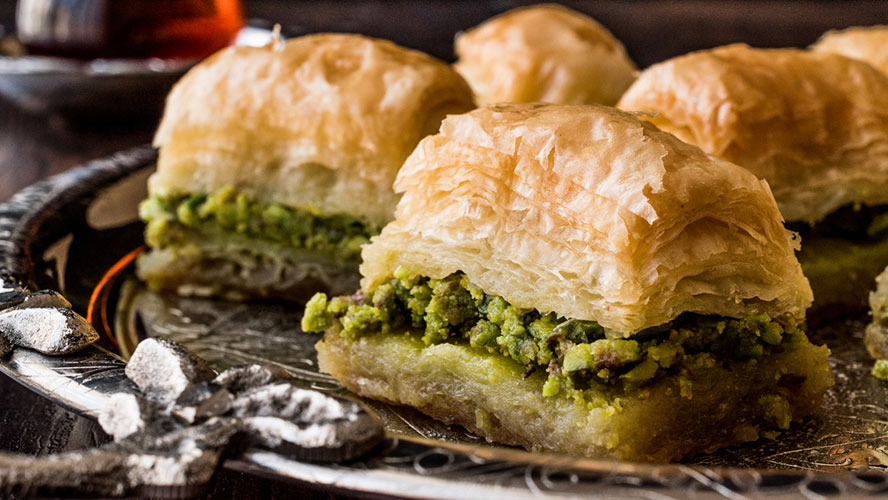
They come in different shapes, sizes and forms, but always with the same base: a crispy, flaky filo pastry which is packed with nuts (most commonly pistachios, walnuts and almonds) and dipped in lots and lots of honey.
The international doner kebab
As we’ve already touched on, of all the typical Turkish dishes, the doner kebab is undoubtedly the best known and most popular dish. Its name translates as ‘rotating grilled meat’. And that is the essence of this dish.
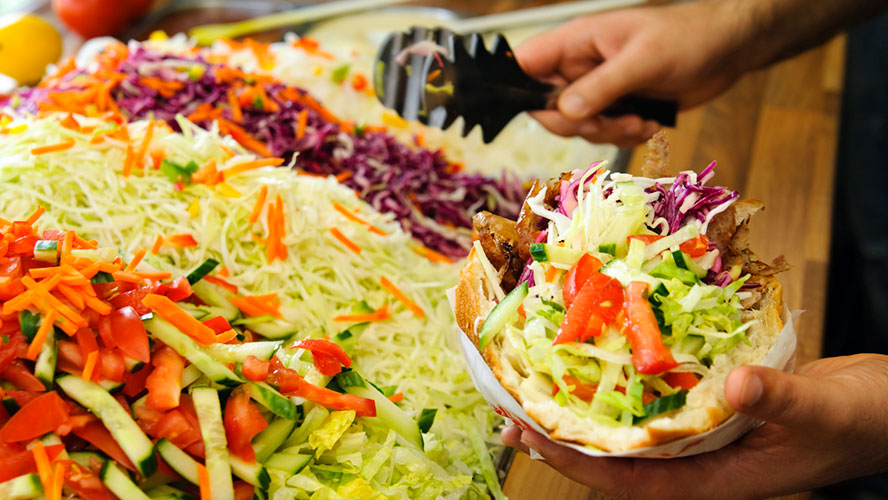
As we’ve already touched on, of all the typical Turkish dishes, the doner kebab is undoubtedly the best known and most popular dish. Its name translates as ‘rotating grilled meat’. And that is the essence of this dish.
Lahmacun
Many Turkish restaurants serve a dish called lahmacun (or lehmeyun), which is described as “the Turkish pizza”. This typical dish does indeed look like the classic Italian meal, although there are several notable differences that must be addressed.
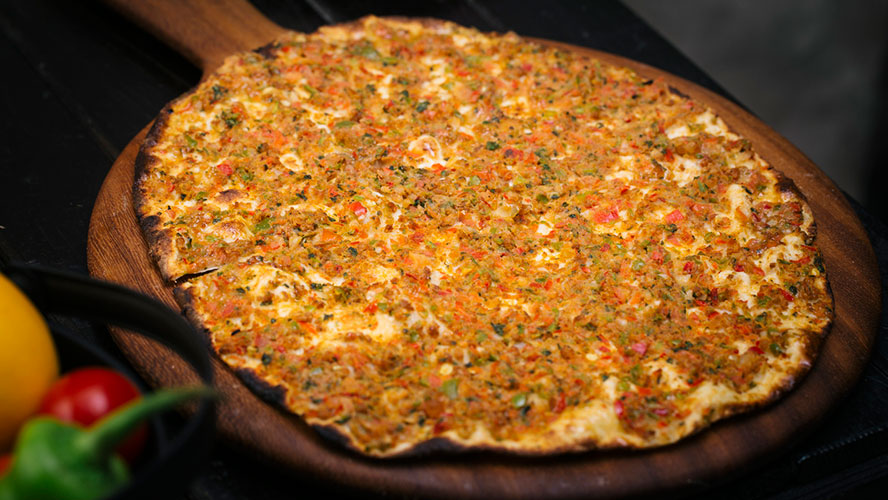
The first is that it does not have any mozzarella (or any other cheese, for that matter). The second is that the minced meat that sits on top of the dough is cooked with onion, parsley, peppers and all kinds of spices. This dish is both delicious and filling, making it a great option if you’re in a rush at lunchtime.
Dolma
The word ‘dolma’ translates as “filling”, or something that is stuffed with something else. In Turkey (and other Islamic countries and Greece), ‘dolmas’ are always associated with grape leaves that are stuffed with cooked rice and occasionally pieces of meat, which are subsequently drizzled with lemon.
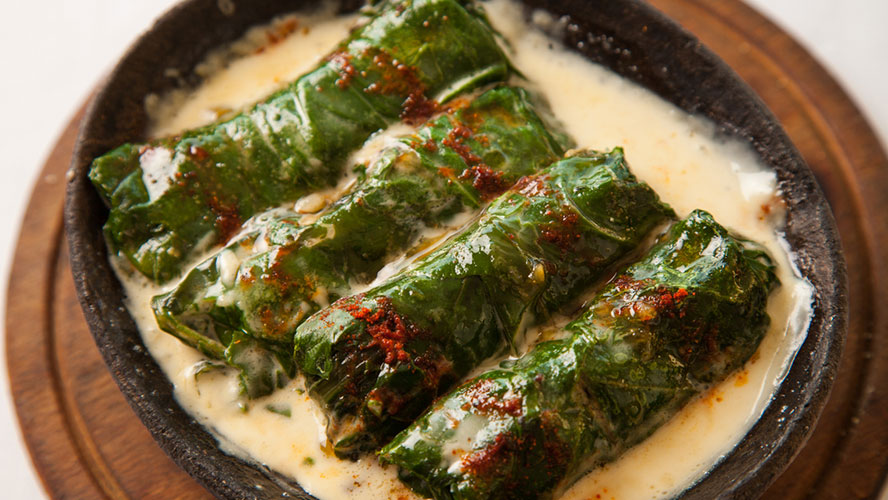
This famous Turkish dish is an irresistible appetiser.
Meze
Meze are the most typical Turkish appetisers: dishes of various salads, pickles and roasted vegetables (such as aubergines or peppers) drizzled in delicious sauces, as well as skewers of chicken, lamb and dried fruits.
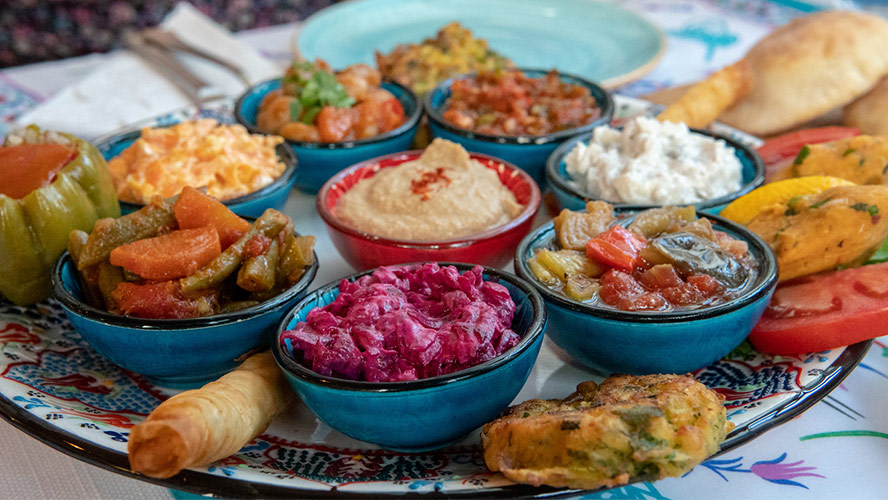
Börek
This is the name given to a type of pie or pastry made from a filo-like dough, which is filled with a white Turkish cheese or feta, minced meat (or a vegetarian alternative) and some vegetables. The dish is also known as ‘boreca’ or ‘bureca’. It is often served with a Turkish tea. The spinach variety is simply delicious, so make sure you try it!

Menemen
Menemen is the name given to the Turkish take on the classic dish of scrambled eggs, which is enjoyed for breakfast all around the world. In this version, the eggs are accompanied with small pieces of vegetables such as tomatoes, onions and peppers…
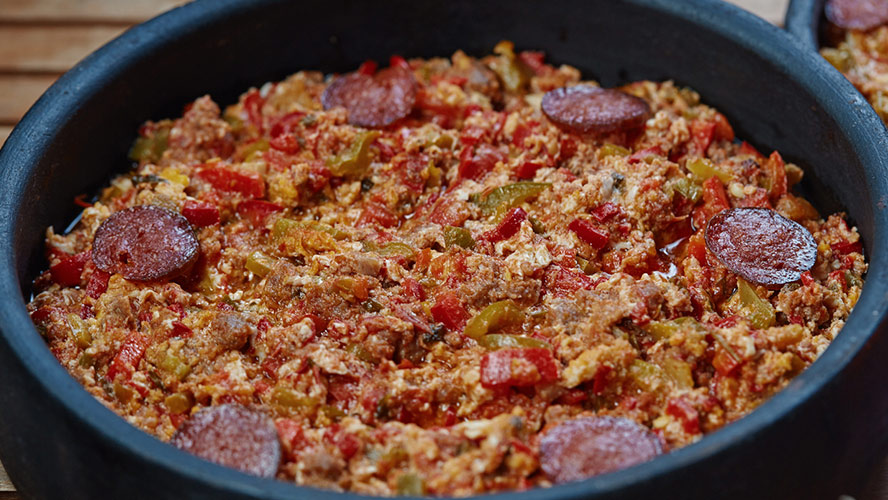
Pilav
Pilav is the quintessential accompaniment to any Turkish meal. However, it comes in not one but many different formats. In essence, in Turkey the word refers to different rice recipes.
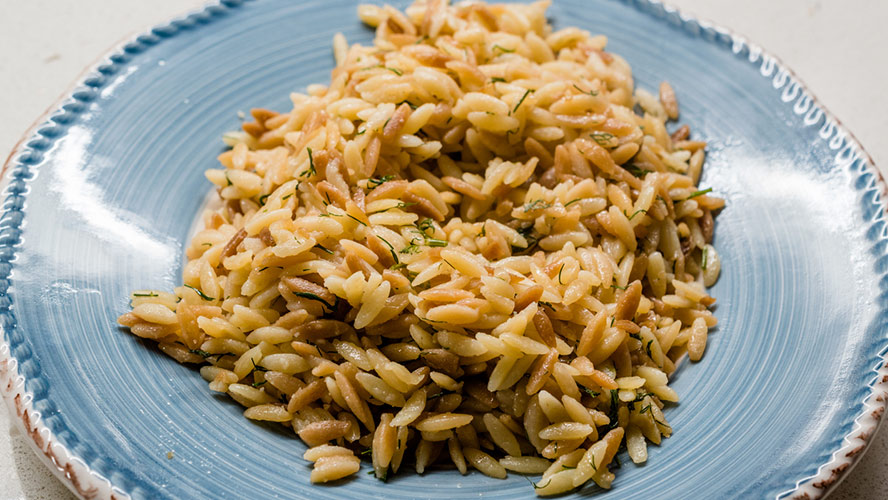
Many of them have a clear Eastern influence (pilav is the typical Indian rice) and they are often seasoned with spices and vegetables. Also, each recipe uses a different type of rice.
Manti
Manti (or mantu) is one of the most distinctly eastern dishes in Turkish cuisine. In fact, Turkey shares this dish with many other Central Asian countries, such as Armenia, Uzbekistan and Kazakhstan.
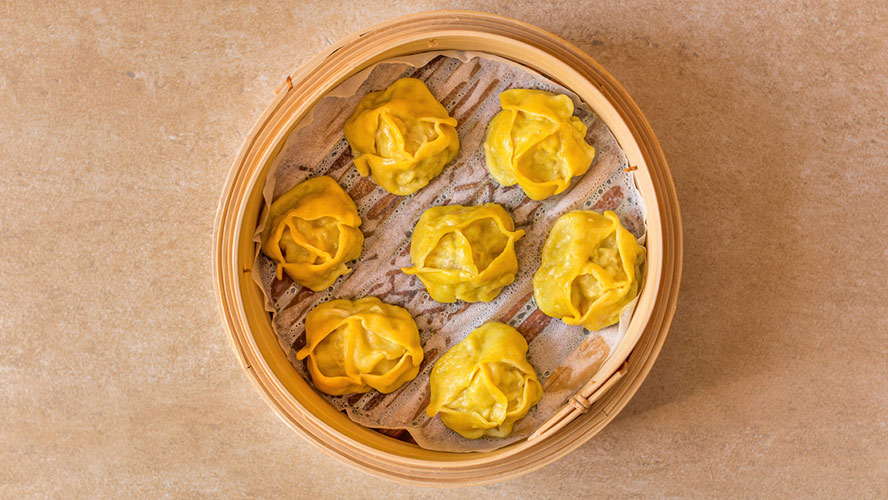
Manti is the name given to a pastry stuffed with lamb meat, bathed in a rich yoghurt sauce and seasoned with onion and various spices.
Köfte
Köfte (or kofta) are meatballs, generally made from beef or lamb, which are mixed with onion and – as you might expect – seasoned with various spices. They are usually cooked over a wood fire and are simply delicious.
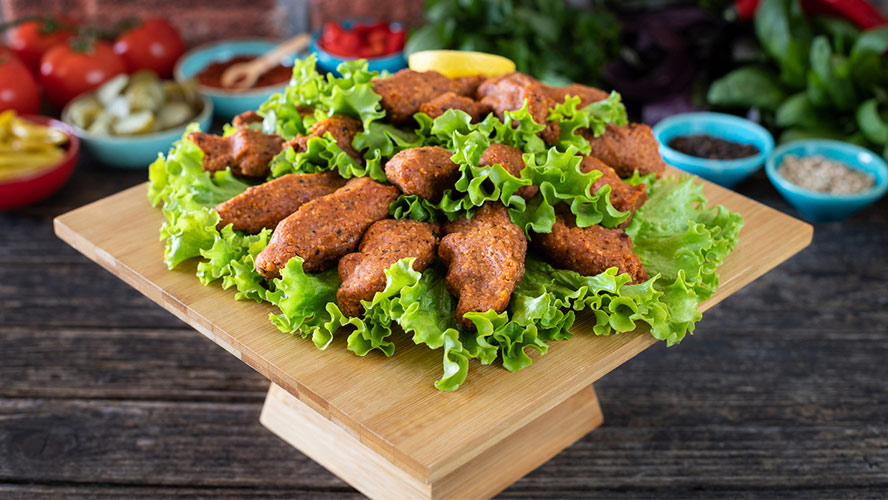
Mercimek köftesi
Mercimek köftesi are the Turkish equivalent of Spanish croquettes. They are, however, entirely vegetarian, as the dough used to make them is made of lentil flour (and occasionally wheat flour).
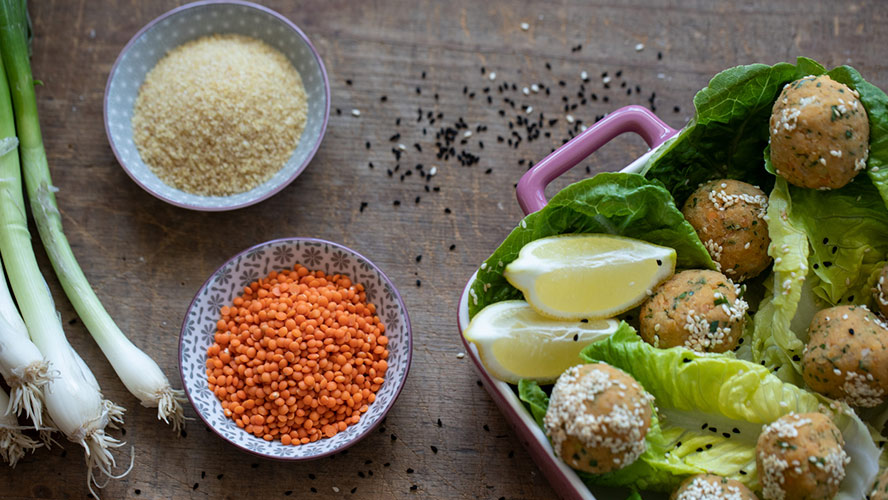
They are usually dipped in spicy sauces such as muhhamara, which is made with peppers and dried fruits.
Pide’, a snack for quick consumption
If you have already been to Turkey, I am sure that when you read ‘pide’ you have thought of that flat bread, similar to pita bread, that they make there and that is so good. Well, you should know that, apart from that bread, the ‘pide’ is also a food and that depending on the place where you try it, it will be different, since there are variants in different parts of Turkey. To give you an idea, the ‘pide’ is similar to pizza, but smaller and longer, on which a series of ingredients are placed and then put in a stone or wood oven.
In some places, such as in the Black Sea area, the ingredients are put inside as in a pie. Some ‘pide’ options have minced meat, beef or sheep, and cheese. But in the variant called ‘yagli’ the ‘pide’ is spread with butter, an egg is added on top, and then it goes into the oven.
A curious tradition is that if you want to make it at home and you don’t have a suitable oven, in some villages of Turkey they take it without any problem to the neighborhood bakery.
Lökum, Turkish delicacies
If you have a sweet tooth and a gastronomic curiosity, you will love lökum, a type of pastry also known as Turkish delight. These compact jelly morsels have dried fruits (pistachios, walnuts, hazelnuts, etc.) and are coated with sugar or coconut. Aesthetically they are very nice because of the contrast of colors and textures. They are usually offered when you order a coffee, but it is also possible to buy them in supermarkets and street stalls. It is advisable to make sure that they are recent and meet hygiene standards. In some bakeries they are sold in little boxes, like chocolates, so they can be a good gastronomic souvenir.
Lüfer, blue fish from the Bosphorus
If your favorite foods are not those with beef or lamb, in Istanbul you can opt for fish. And if it is fresh and comes from the Bosphorus, so much the better. When you see “lüfer” on the menu, it refers to an oily fish that is very common in this area and tastes very good even with the simplest preparations. Grilled with oil, garlic, pepper and a few spices, plus some vegetables to go with it, it is delicious. Fish experts say that if you want to eat fresh lüfer you should order it between August and December.
Typical Turkish drinks
A preliminary consideration: in Turkey, food may be accompanied by wine or beer. In fact, both of these beverages are produced here and are renowned for their excellent quality. However, as a majority Muslim country, there are many non-alcoholic alternatives that are worth trying:
Turkish tea
Known as çay, this is a strong (black) tea that is often brewed in large and striking tea pots. This beverage can be enjoyed at any time of day.
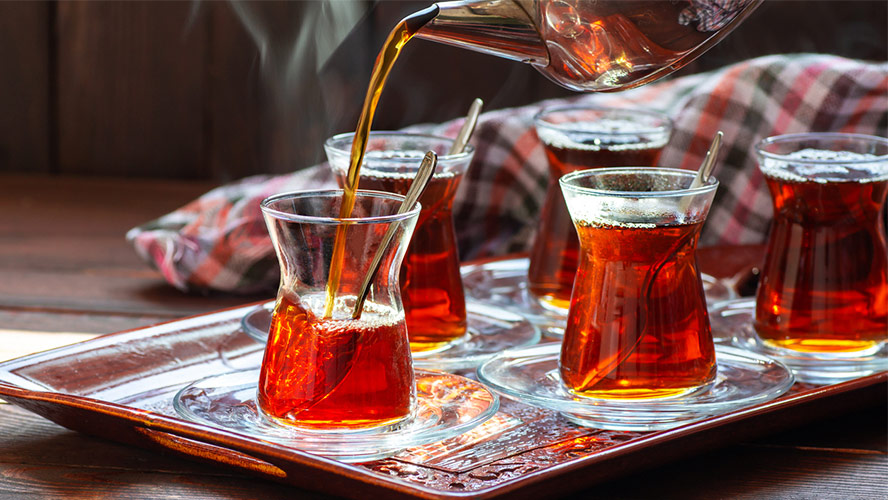
Turkish coffee
As popular, if not more popular than tea, Turkish coffee is highly concentrated and brewed directly in a pot of water without a filter. This means that very few grounds are left at the bottom.
Ayran
This is one of the most popular Turkish drinks during the warmer months of the year. It is a kind of milkshake made with yoghurt and water, topped off with lots of foam.
Raki
This alcoholic beverage is shared with many other countries of Ottoman influence (including Greece). It is very similar to other aniseed-flavoured drinks from the Mediterranean, such as pastis and ouzo.
Turkish ice creams
Rather than the quality of the dessert itself, what makes Turkish ice creams stand out is the skill and slight of hand exhibited by the street sellers, who attract potential clients with the way they play tricks on paying customers. They are particularly popular in the old part of Istanbul.
These are usually milk-based sorbets available in various flavours, served in tubs or biscuit cones.










































































